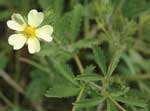Sulfur cinquefoil
Potentilla recta L.
Keys to Identification
- Leaves are palmately compound, have 5-7 toothed leaflets, and somewhat resemble a marijuana leaf.
- Light-yellow flowers have five petals that are deeply notched.
- Leaf stalks have perpendicular hairs longer than the width of the stalk.
This information courtesy of the Colorado Natural Areas Program
Family
Rose (Rosaceae)
Other Names
Rough-fruited cinquefoil
USDA Code
PORE5
Legal Status
Colorado Noxious Weed List B
Identification
Lifecycle
Perennial
Growth form
Forb
Flower
Flowers are light-yellow with 5 petals.
Seeds/Fruit
Each flower produces numerous small seeds (.05 in long) that are slightly flattened.
Leaves
Leaves are alternate, palmately compound with 5-7 toothed leaflets on each leaf. Leafstalks have conspicuous perpendicular hairs, and leaves appear green on the underside. Most native cinqufoils in Colorado have light colored hairs on the underside of the leaves.
Stems
Mature plants are 1-1.5 ft tall with one to several stems growing from well-developed rootstocks (Whitson et al. 1996).
Roots
Fibrous roots and lateral rhizomes.
Seedling
No information available.
Similar Species
Natives
Potentilla sp.
Impacts
Agricultural
Sulfur cinquefoil is unpalatable to grazing animals, therefore it reduces forage for livestock and wildlife where it is abundant (Rice 1999).
Ecological
Sulfur cinquefoil is a competitive early successional weed that persists until a woody cover is present. It can dominate a site after within 2-3 years of first appearance (FEIS 1998). Sulfur cinquefoil has a long lifespan, and twenty year old plants are not uncommon (FEIS 1998). Sulfur cinquefoil has been known to invade bluebunch wheatgrass rangeland in good condition (FEIS 1998). In Montana, it is actually out-competing spotted knapweed on some sites (FEIS 1998).
Habitat and Distribution
General requirements
Although colonies of sulfur cinquefoil can be found in undisturbed sites, it is commonly found in disturbed grasslands, shrubby areas, and old fields. Sulfur cinquefoil grows on dry sandy, gravelly, and rocky soils, and prefers climates that receive from 13-50 in annual precipitation.
Distribution
Naturalized throughout much of North America. It is typically found in low to middle elevations in the Intermountain west.
Historical
Sulfur cinquefoil is a native of Eurasia that was first introduced into North America before 1900 (FEIS 1998).
Biology/Ecology
Life cycle
Seeds of sulfur cinquefoil may germinate at any time during the growing season provided soil moisture is adequate. However, seeds don’t germinate when temperatures are high (usually during July and August). Growth begins early in spring. Sulfur cinquefoil flowers from May to July with peak flowering generally occurring in late June.
Mode of reproduction
Sulfur cinquefoil has an unusual means of vegetative reproduction. Annual regrowth each spring eventually causes individual plants to become several closely-spaced independent plants. Also, plants that are knocked to the ground can produce roots at the nodes.
Seed production
No information available
Seed bank
Seeds may remain viable in the soil for more than four years.
Dispersal
No information available.
References
Duncan, C.L. 1993. Chemical control of sulfur cinquefoil on range and pasture. In: Proceedings of the Montana Weed Control Association Clanay, MT. pg. 11-13.
FEIS – Fire Effects Information System [Online] (1996, September). Prescribed Fire and Fire Effects Research Work Unit, Rocky Mountain Research Station (producer), US Forest Service. Available: www.fs.fed.us/database/feis/ [1998,March 12]
Rice, P. 1999. Sulfur cinquefoil. In R.L. Sheley and J.K. Petroff (eds.) Biology and management of noxious rangeland weeds. Oregon State University Press, Corvallis. pg. 382-388.
Whitson, T.D.(ed.), L.C. Burrill, S.A. Dewey, D.W. Cudney, B.E. Nelson, R.D. Lee, R. Parker. 1996. Sulfur cinquefoil. Weeds of the West. Western Society of Weed Science, in cooperation with the Western United States Land Grant Universities Cooperative Extension Services, Newark CA. pg. 536.

